BONE TUMORS Prepared by: Yermek Alma Checked by:

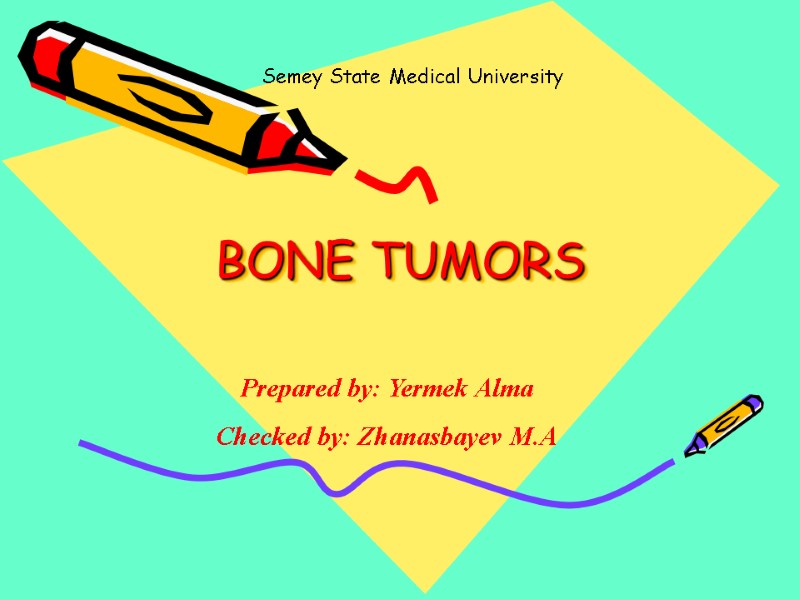
BONE TUMORS Prepared by: Yermek Alma Checked by: Zhanasbayev M.A Semey State Medical University
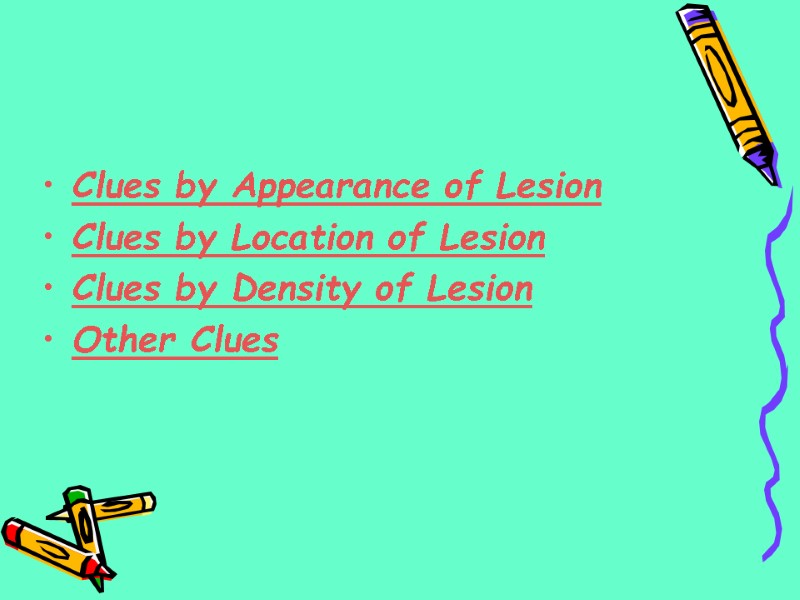
Clues by Appearance of Lesion Clues by Location of Lesion Clues by Density of Lesion Other Clues
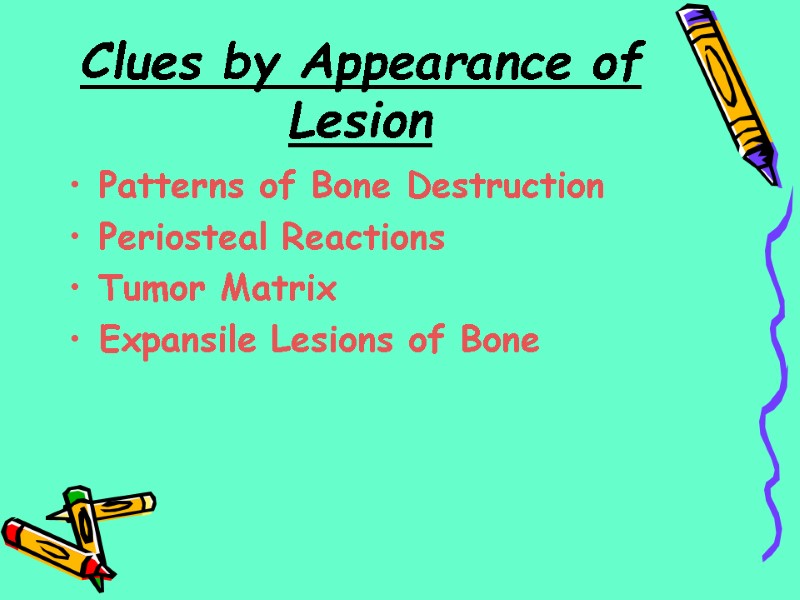
Clues by Appearance of Lesion Patterns of Bone Destruction Periosteal Reactions Tumor Matrix Expansile Lesions of Bone
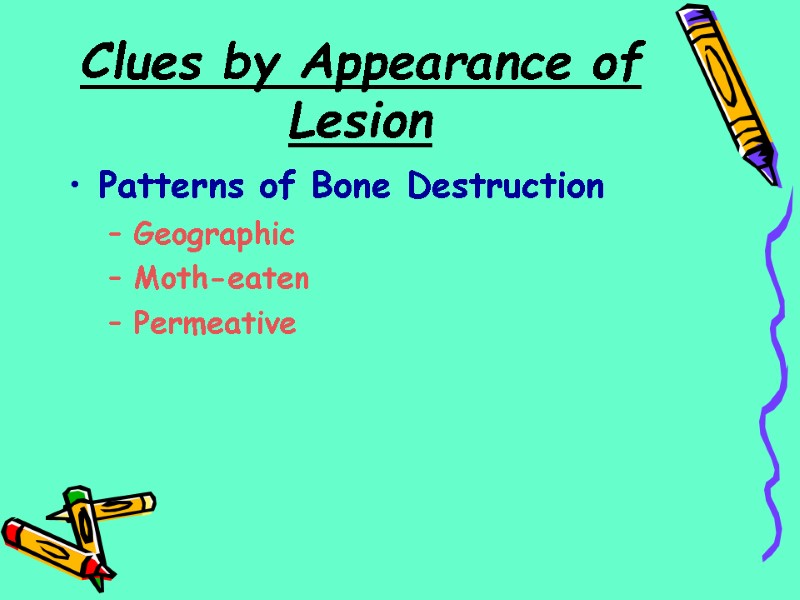
Clues by Appearance of Lesion Patterns of Bone Destruction Geographic Moth-eaten Permeative
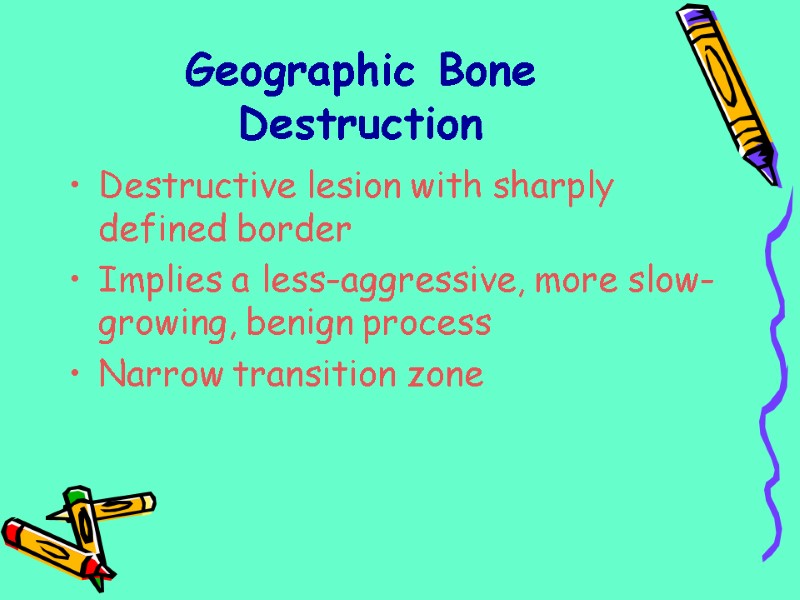
Geographic Bone Destruction Destructive lesion with sharply defined border Implies a less-aggressive, more slow-growing, benign process Narrow transition zone
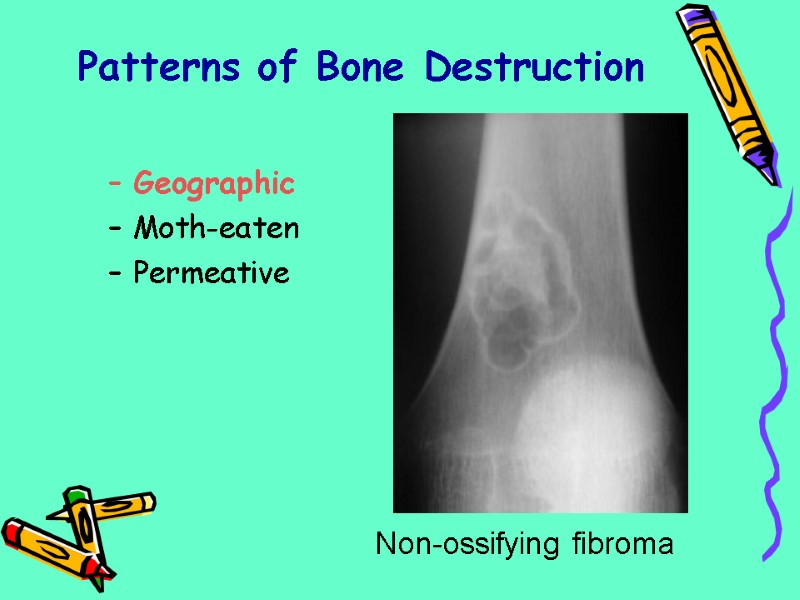
Patterns of Bone Destruction Geographic Moth-eaten Permeative Non-ossifying fibroma
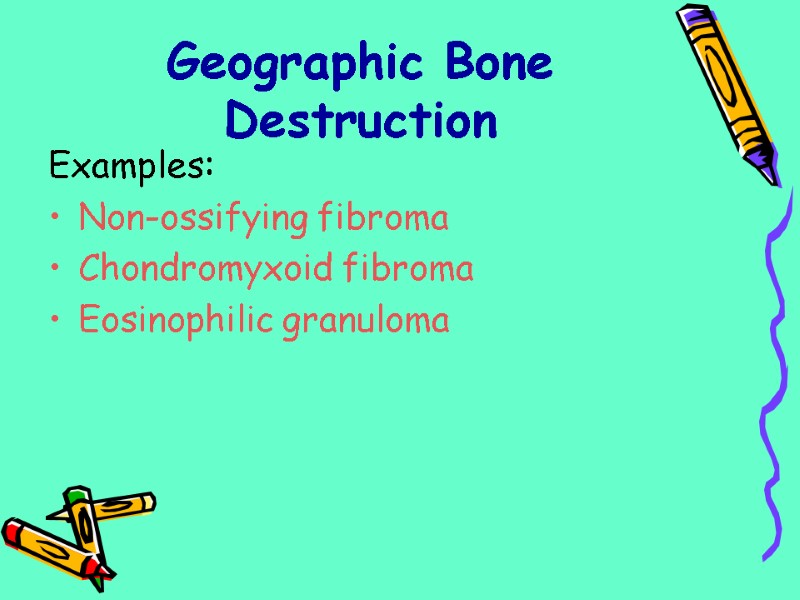
Geographic Bone Destruction Examples: Non-ossifying fibroma Chondromyxoid fibroma Eosinophilic granuloma
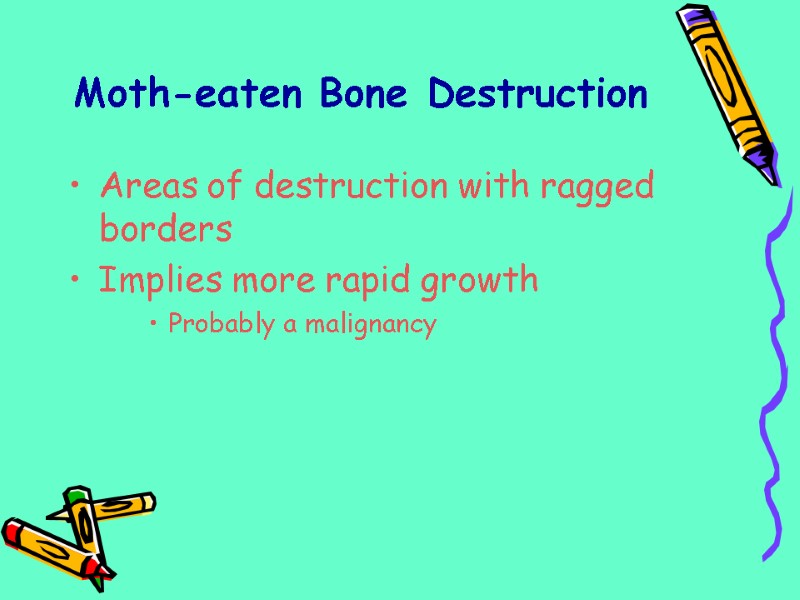
Moth-eaten Bone Destruction Areas of destruction with ragged borders Implies more rapid growth Probably a malignancy
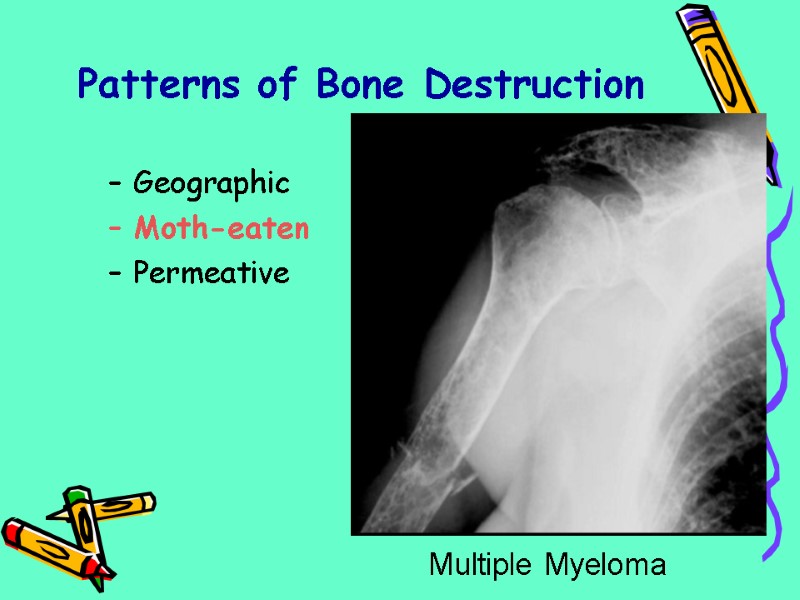
Patterns of Bone Destruction Geographic Moth-eaten Permeative Multiple Myeloma
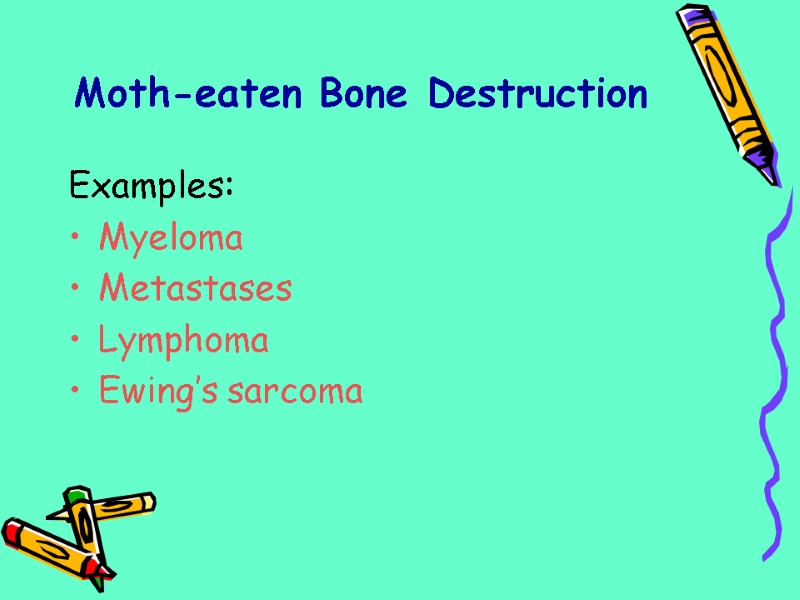
Examples: Myeloma Metastases Lymphoma Ewing’s sarcoma Moth-eaten Bone Destruction
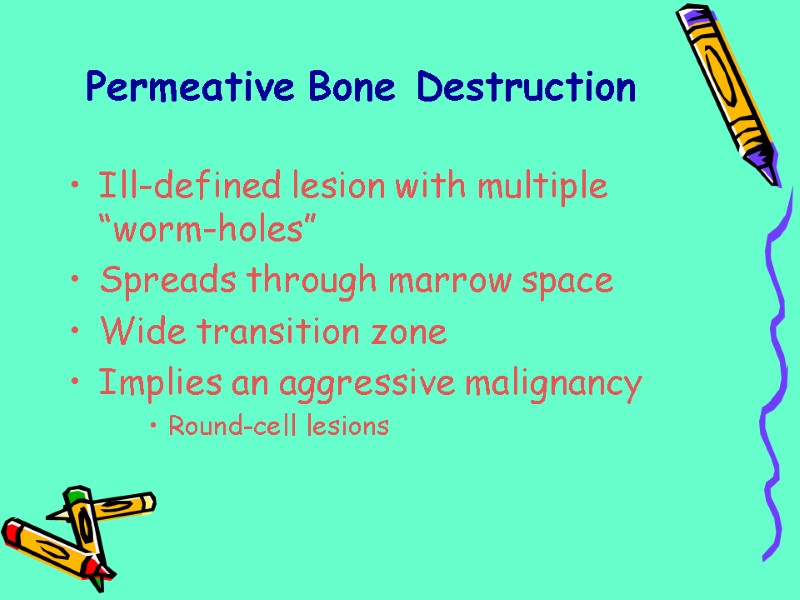
Permeative Bone Destruction Ill-defined lesion with multiple “worm-holes” Spreads through marrow space Wide transition zone Implies an aggressive malignancy Round-cell lesions
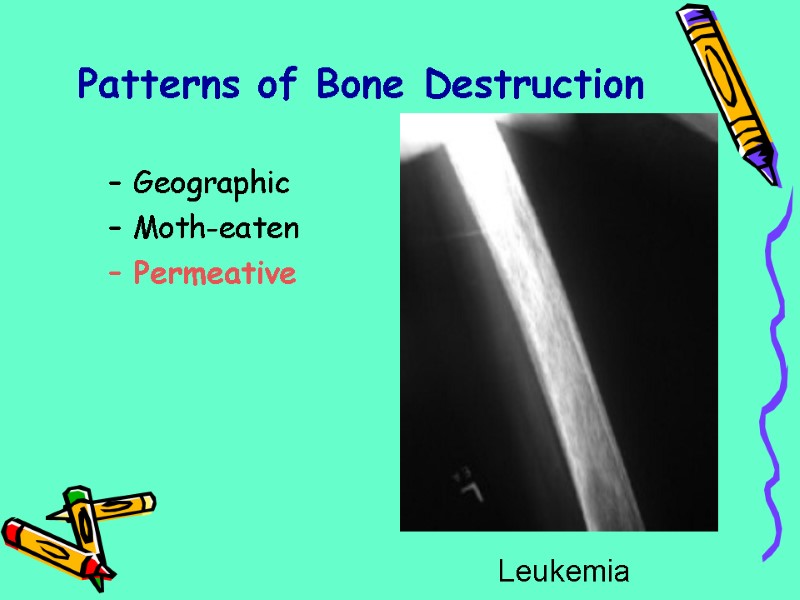
Patterns of Bone Destruction Geographic Moth-eaten Permeative Leukemia
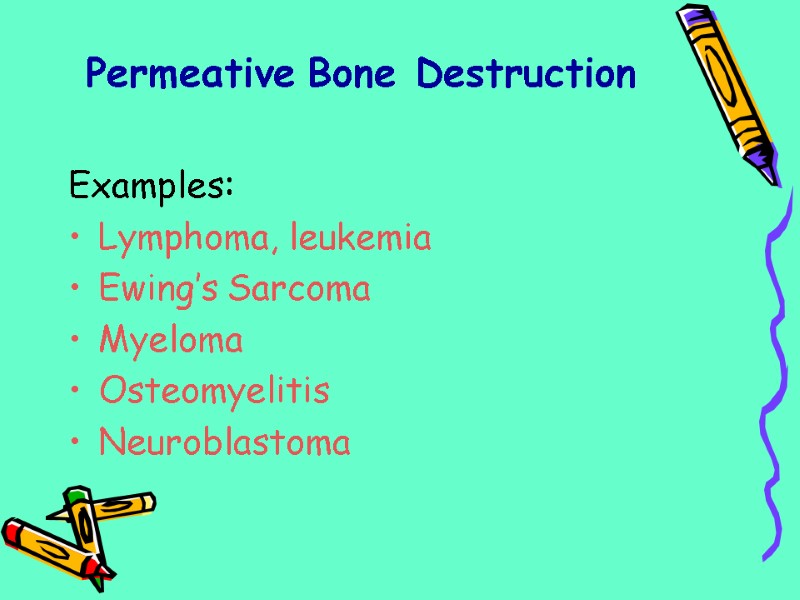
Examples: Lymphoma, leukemia Ewing’s Sarcoma Myeloma Osteomyelitis Neuroblastoma Permeative Bone Destruction
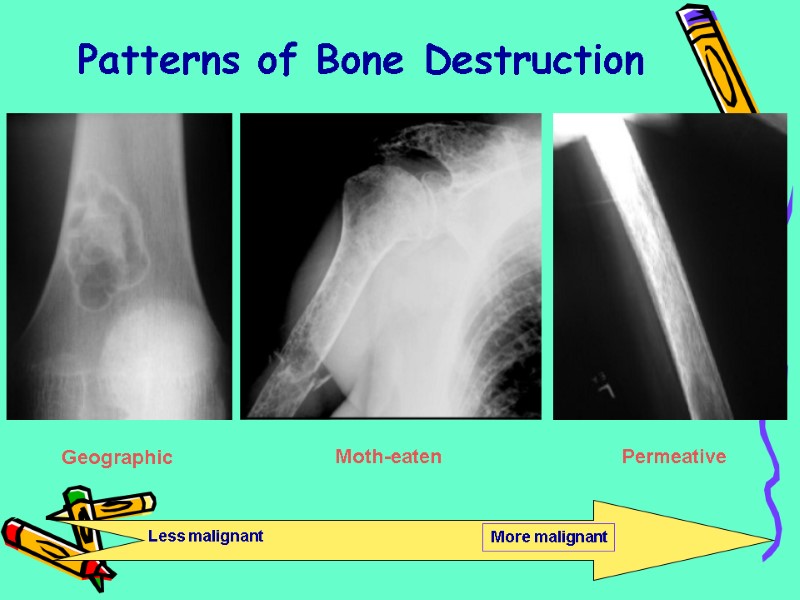
Patterns of Bone Destruction Geographic Moth-eaten Permeative

Periosteal Reactions Benign None Solid More aggressive or malignant Lamellated or onion peel Sunburst Codman’s triangle
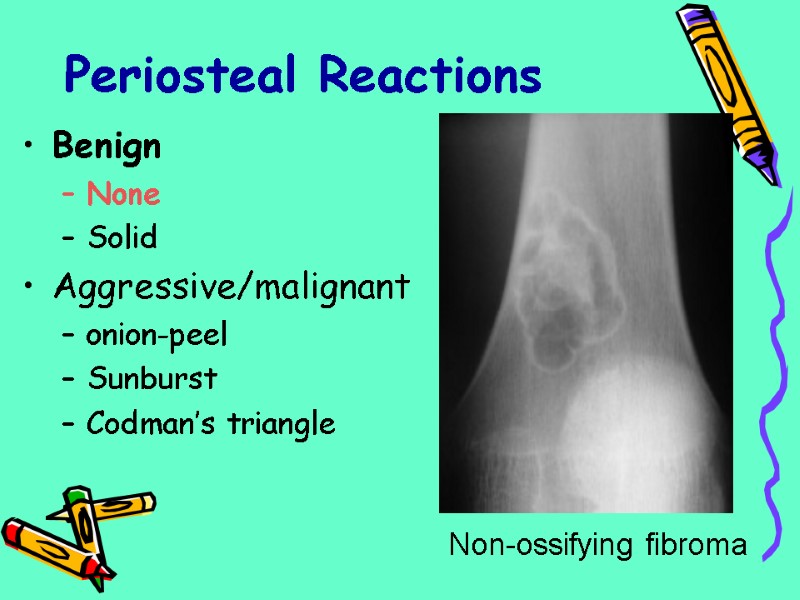
Periosteal Reactions Benign None Solid Aggressive/malignant onion-peel Sunburst Codman’s triangle Non-ossifying fibroma
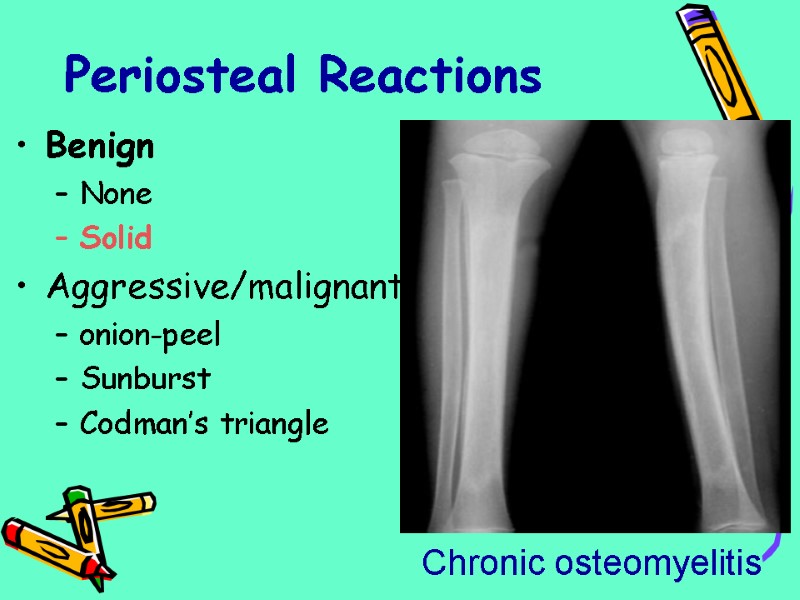
Periosteal Reactions Benign None Solid Aggressive/malignant onion-peel Sunburst Codman’s triangle Chronic osteomyelitis
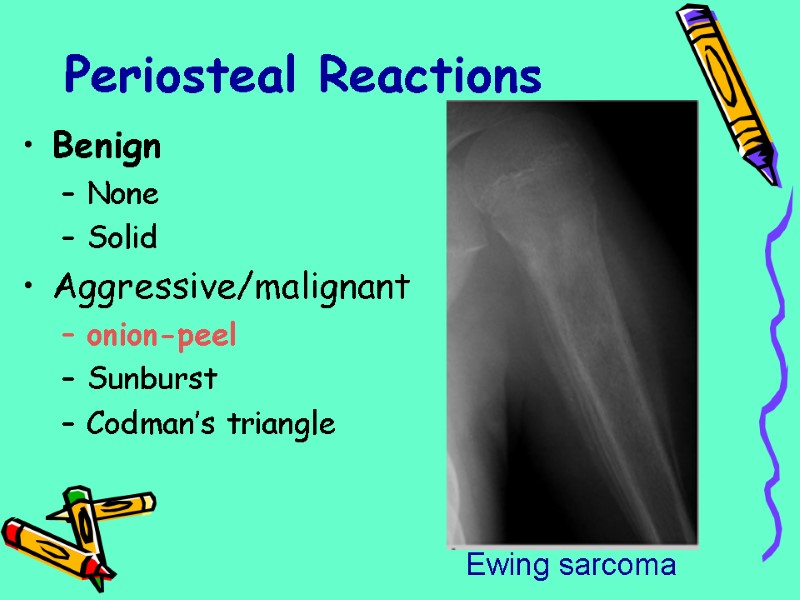
Periosteal Reactions Benign None Solid Aggressive/malignant onion-peel Sunburst Codman’s triangle Ewing sarcoma
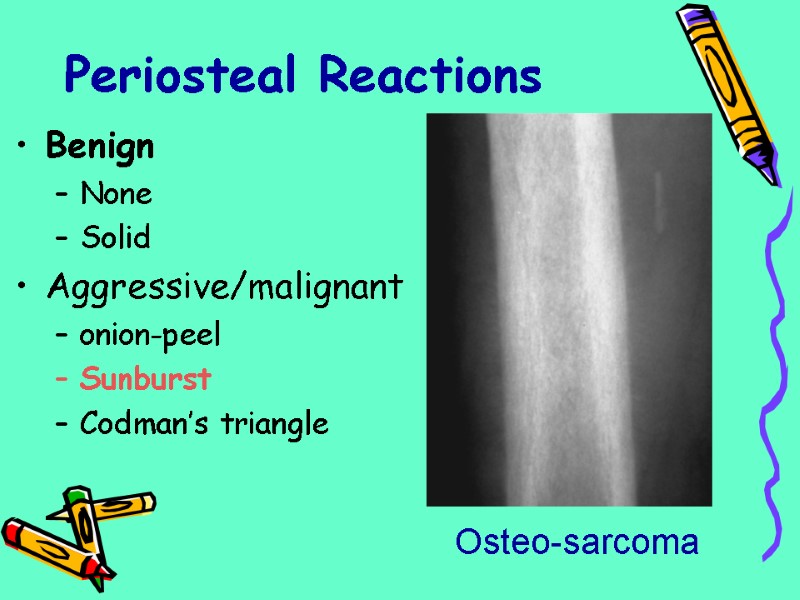
Periosteal Reactions Benign None Solid Aggressive/malignant onion-peel Sunburst Codman’s triangle Osteo-sarcoma
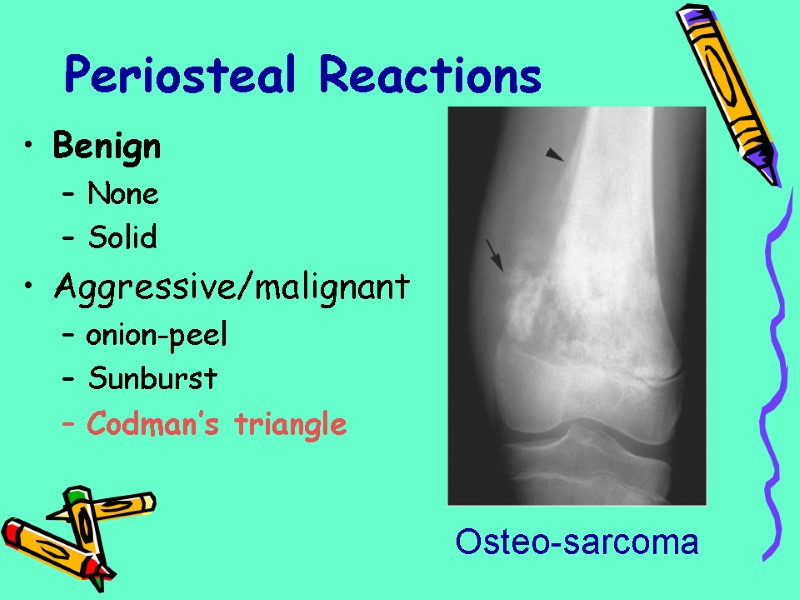
Periosteal Reactions Benign None Solid Aggressive/malignant onion-peel Sunburst Codman’s triangle Osteo-sarcoma

Periosteal Reactions Solid onion-peel Sunburst Codman’s triangle
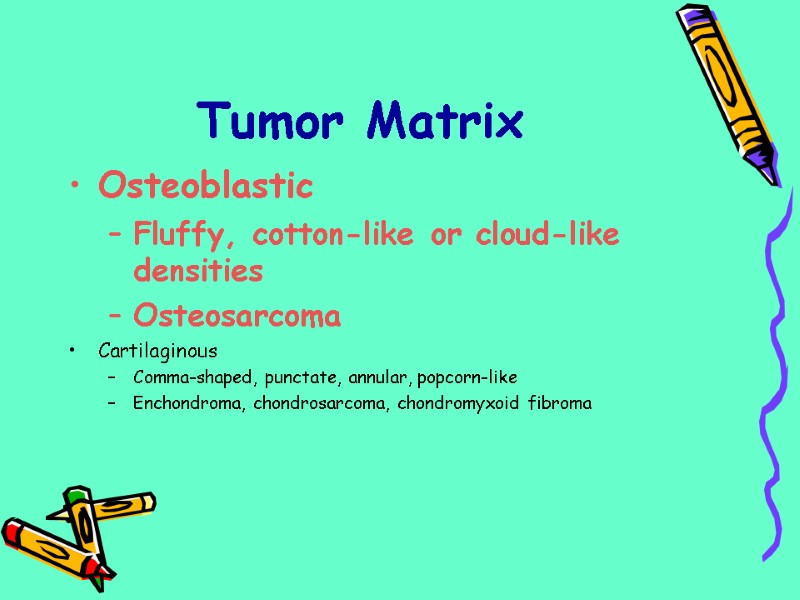
Tumor Matrix Osteoblastic Fluffy, cotton-like or cloud-like densities Osteosarcoma Cartilaginous Comma-shaped, punctate, annular, popcorn-like Enchondroma, chondrosarcoma, chondromyxoid fibroma

Tumor Matrix Osteoblastic Cartilaginous

Osteoblastic Fluffy, cotton-like or cloud-like densities as Osteosarcoma Cartilaginous Comma-shaped, punctate, annular, popcorn-like as Enchondroma, chondrosarcoma, chondromyxoid fibroma Tumor Matrix

Osteoblastic Cartilaginous Tumor Matrix Chondrosarcoma
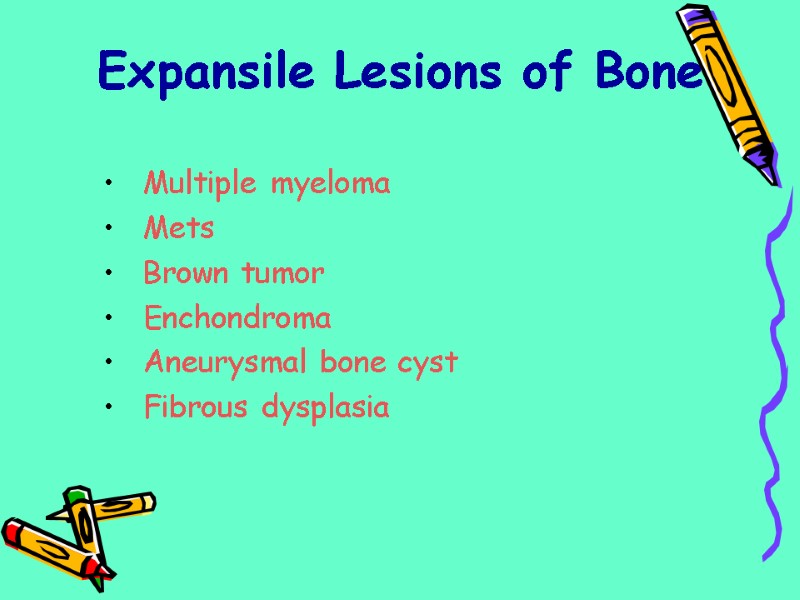
Multiple myeloma Mets Brown tumor Enchondroma Aneurysmal bone cyst Fibrous dysplasia Expansile Lesions of Bone
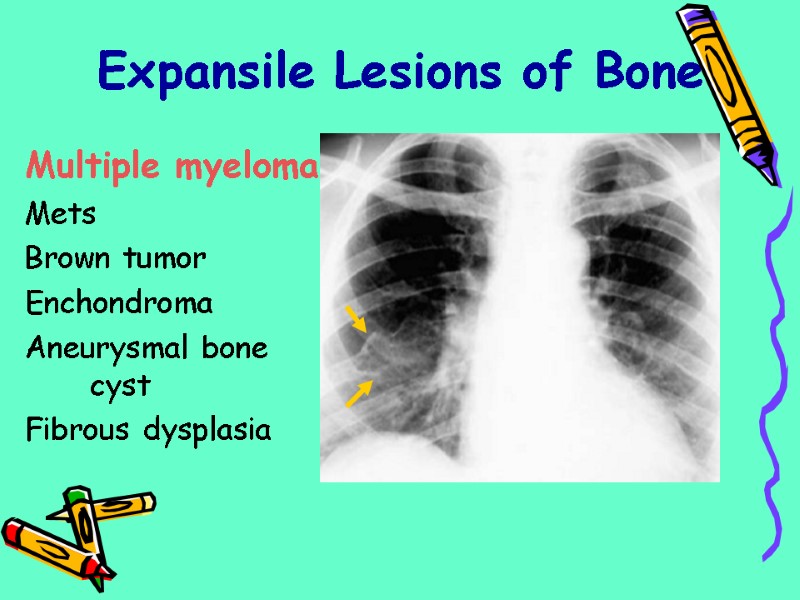
Expansile Lesions of Bone Multiple myeloma Mets Brown tumor Enchondroma Aneurysmal bone cyst Fibrous dysplasia
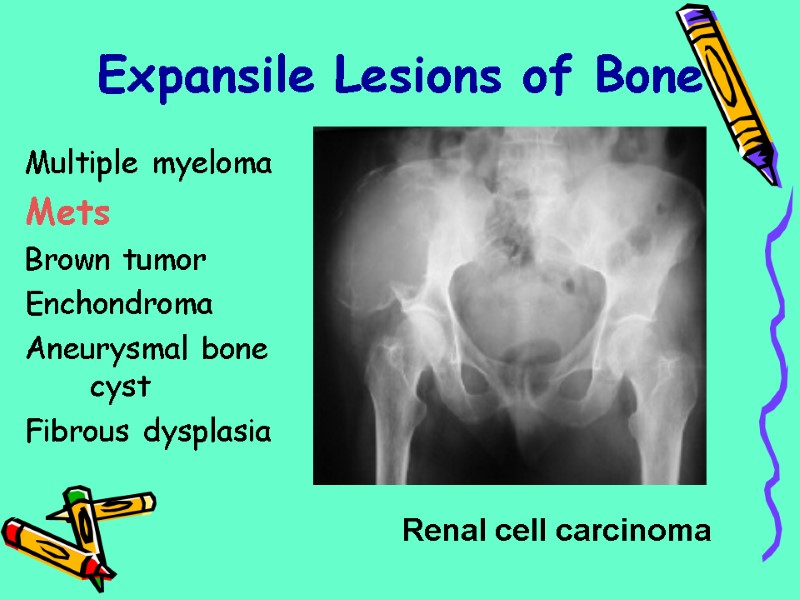
Multiple myeloma Mets Brown tumor Enchondroma Aneurysmal bone cyst Fibrous dysplasia Expansile Lesions of Bone Renal cell carcinoma
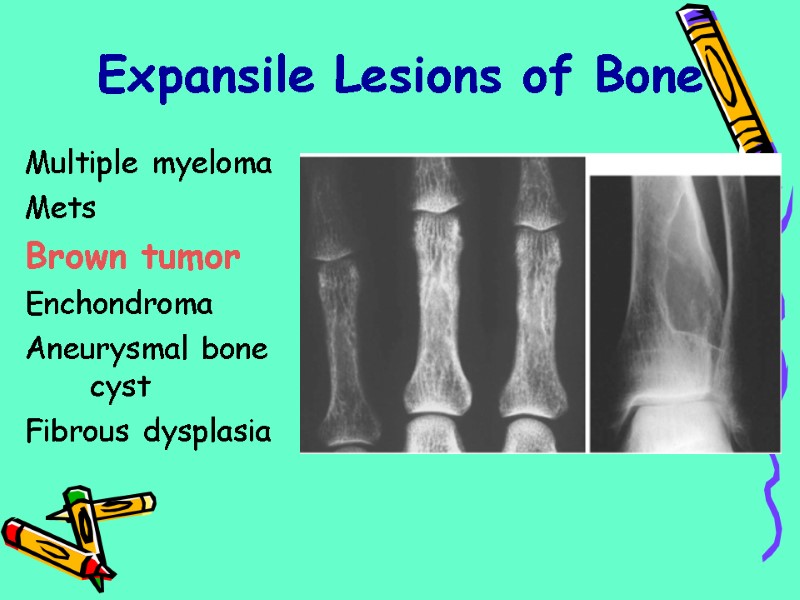
Multiple myeloma Mets Brown tumor Enchondroma Aneurysmal bone cyst Fibrous dysplasia Expansile Lesions of Bone
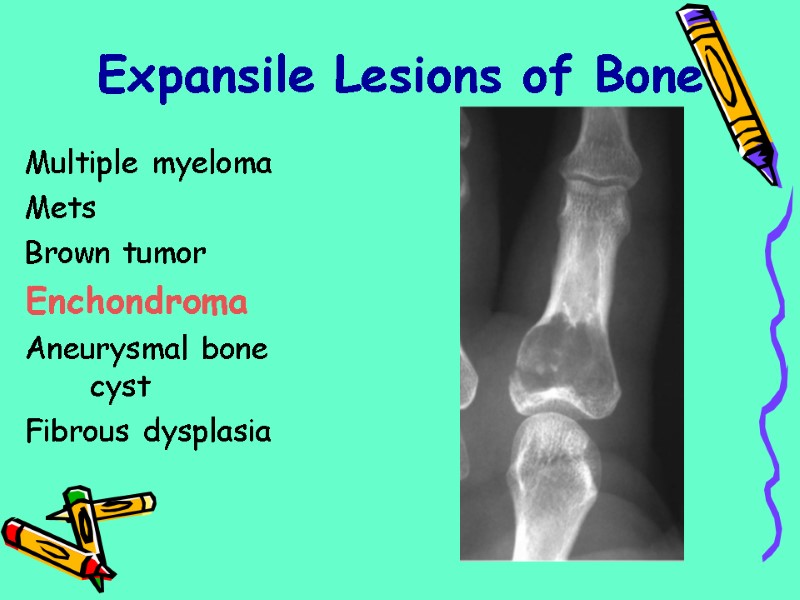
Multiple myeloma Mets Brown tumor Enchondroma Aneurysmal bone cyst Fibrous dysplasia Expansile Lesions of Bone
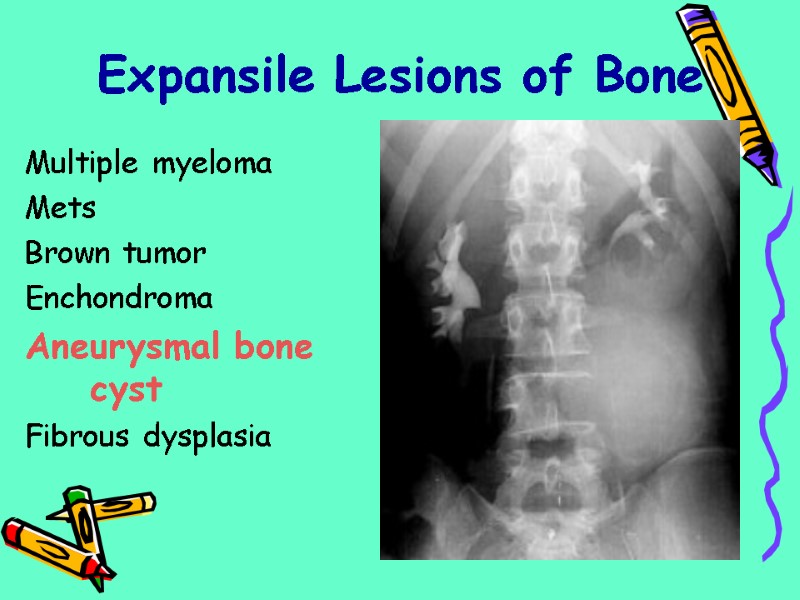
Multiple myeloma Mets Brown tumor Enchondroma Aneurysmal bone cyst Fibrous dysplasia Expansile Lesions of Bone
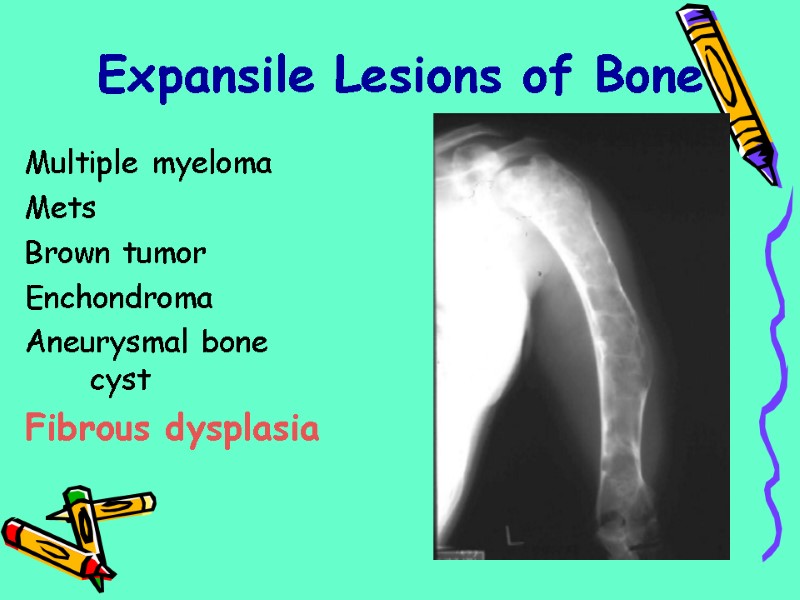
Multiple myeloma Mets Brown tumor Enchondroma Aneurysmal bone cyst Fibrous dysplasia Expansile Lesions of Bone

Clues by Location of Lesion In the Transverse Plane In the Longitudinal Plane Characteristic Locations by tumors Characteristic Tumors by Body Site Pelvic Lesions Expansile Rib Lesions Lesions of the Spine
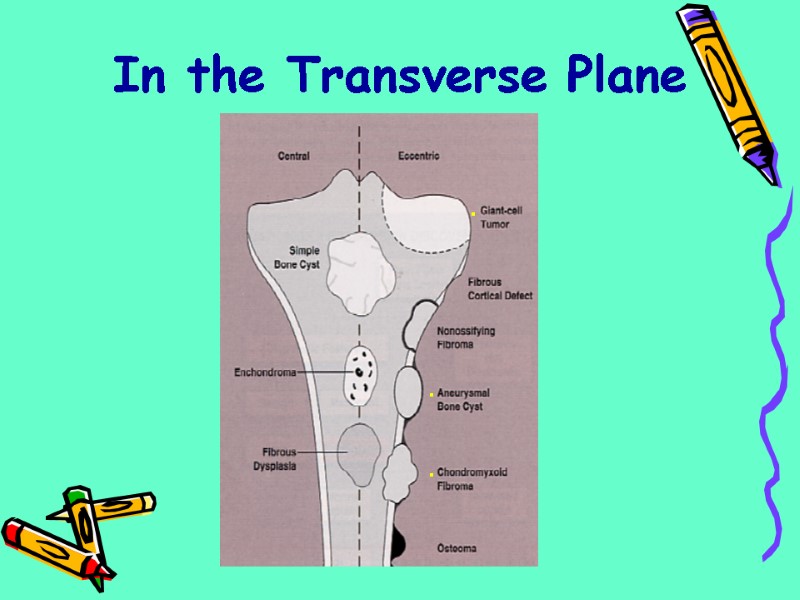
In the Transverse Plane
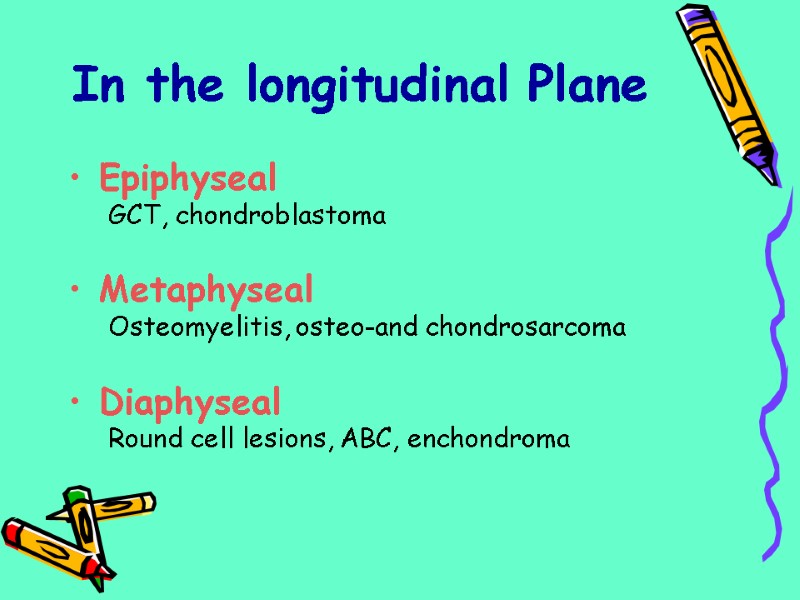
Epiphyseal GCT, chondroblastoma Metaphyseal Osteomyelitis, osteo-and chondrosarcoma Diaphyseal Round cell lesions, ABC, enchondroma In the longitudinal Plane
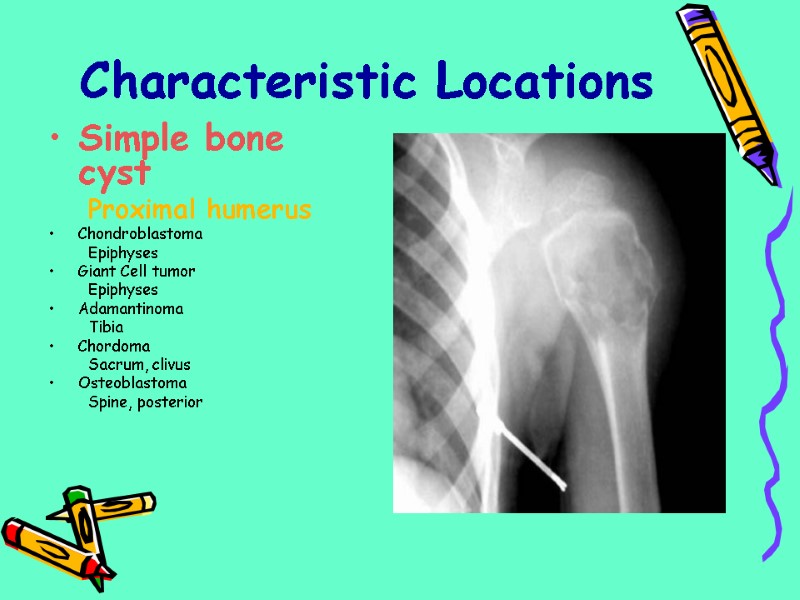
Characteristic Locations Simple bone cyst Proximal humerus Chondroblastoma Epiphyses Giant Cell tumor Epiphyses Adamantinoma Tibia Chordoma Sacrum, clivus Osteoblastoma Spine, posterior
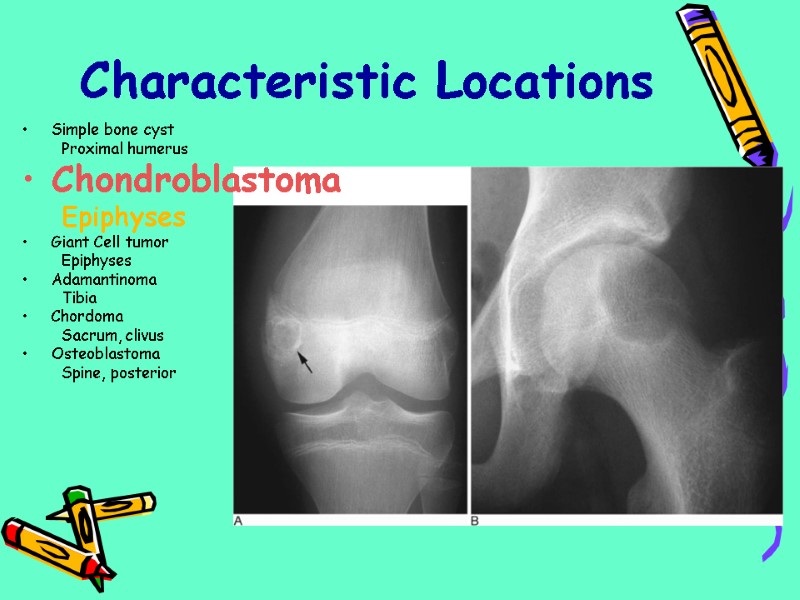
Characteristic Locations Simple bone cyst Proximal humerus Chondroblastoma Epiphyses Giant Cell tumor Epiphyses Adamantinoma Tibia Chordoma Sacrum, clivus Osteoblastoma Spine, posterior
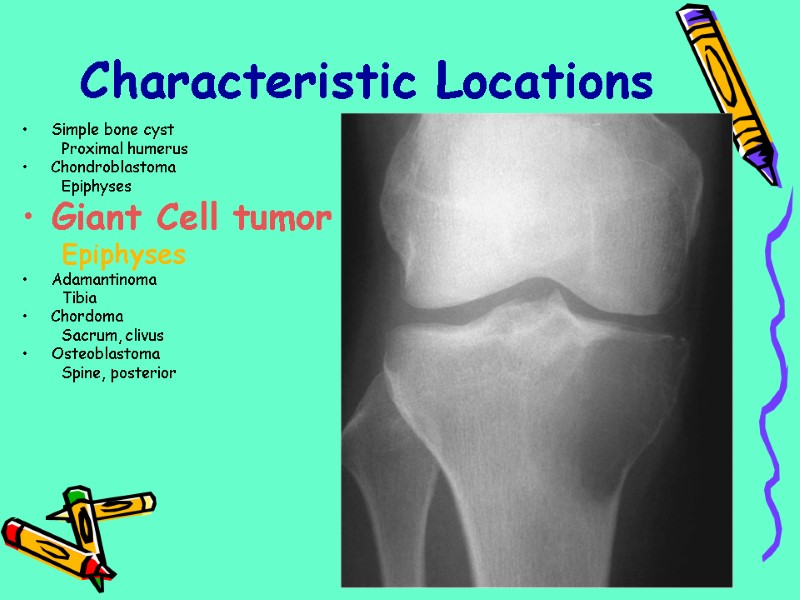
Simple bone cyst Proximal humerus Chondroblastoma Epiphyses Giant Cell tumor Epiphyses Adamantinoma Tibia Chordoma Sacrum, clivus Osteoblastoma Spine, posterior Characteristic Locations
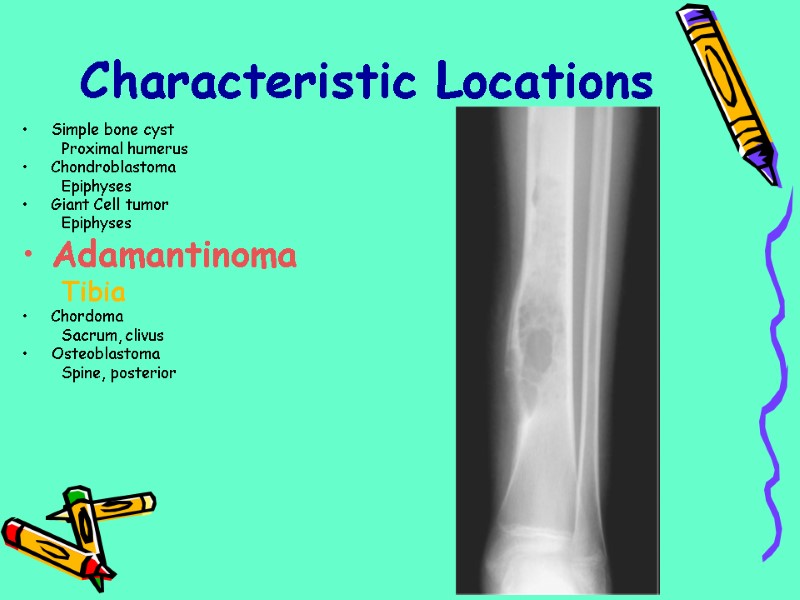
Simple bone cyst Proximal humerus Chondroblastoma Epiphyses Giant Cell tumor Epiphyses Adamantinoma Tibia Chordoma Sacrum, clivus Osteoblastoma Spine, posterior Characteristic Locations
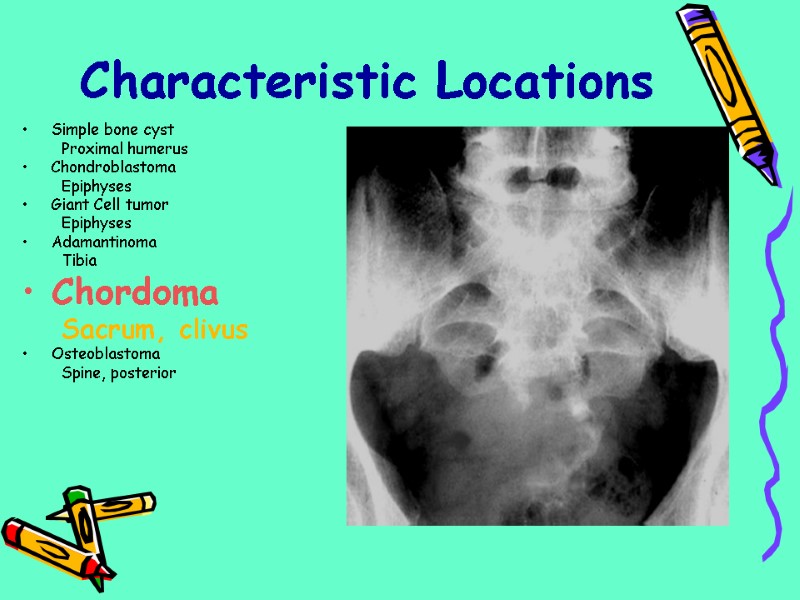
Simple bone cyst Proximal humerus Chondroblastoma Epiphyses Giant Cell tumor Epiphyses Adamantinoma Tibia Chordoma Sacrum, clivus Osteoblastoma Spine, posterior Characteristic Locations
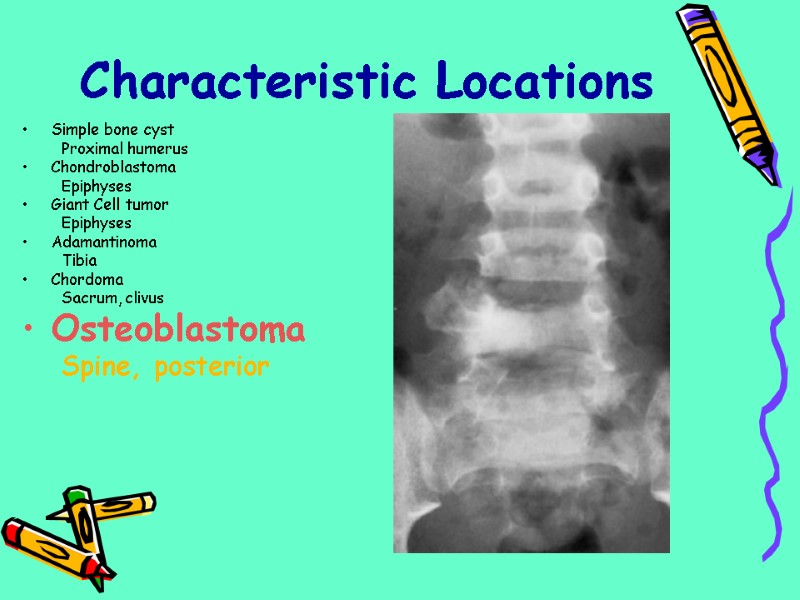
Simple bone cyst Proximal humerus Chondroblastoma Epiphyses Giant Cell tumor Epiphyses Adamantinoma Tibia Chordoma Sacrum, clivus Osteoblastoma Spine, posterior Characteristic Locations
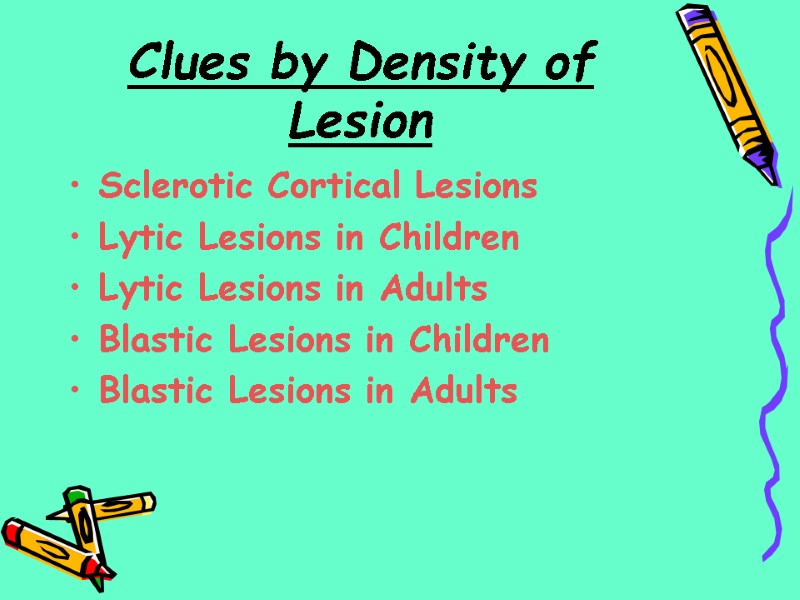
Clues by Density of Lesion Sclerotic Cortical Lesions Lytic Lesions in Children Lytic Lesions in Adults Blastic Lesions in Children Blastic Lesions in Adults
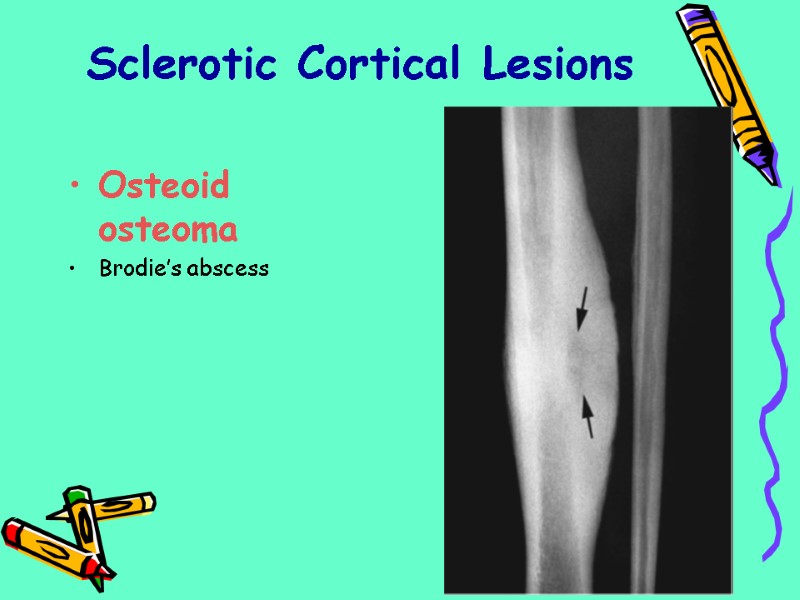
Sclerotic Cortical Lesions Osteoid osteoma Brodie’s abscess
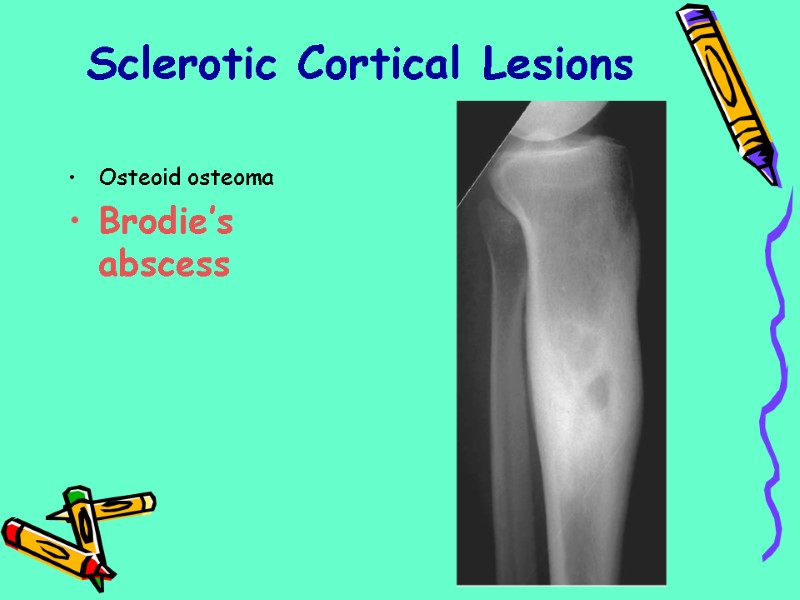
Osteoid osteoma Brodie’s abscess Sclerotic Cortical Lesions
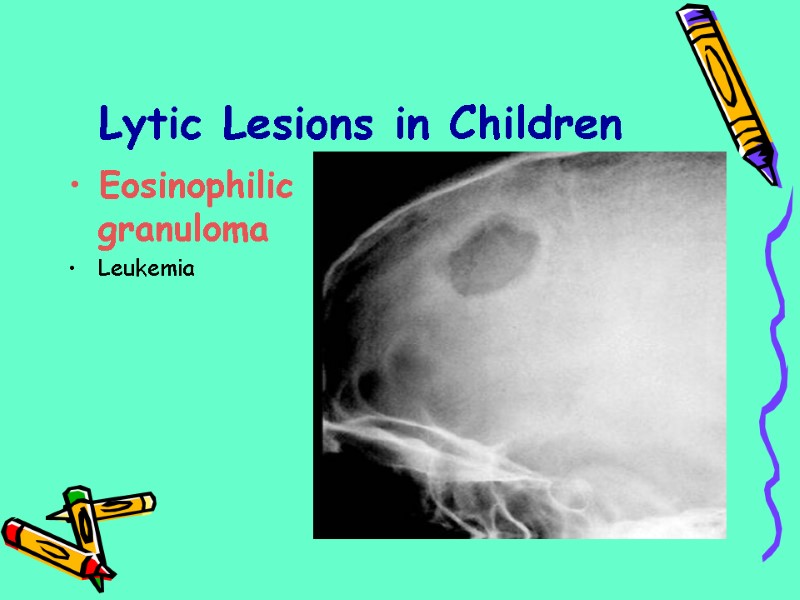
Lytic Lesions in Children Eosinophilic granuloma Leukemia
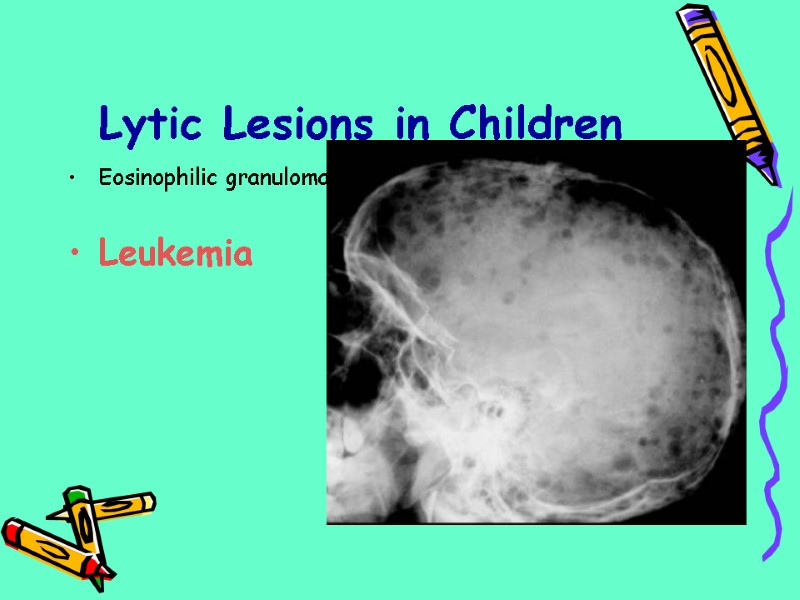
Lytic Lesions in Children Eosinophilic granuloma Leukemia

Lytic Lesions in Adults Metastatic lesions Lung Renal Thyroid Multiple myeloma Primary bone tumor Metastatic thyroid carcinoma
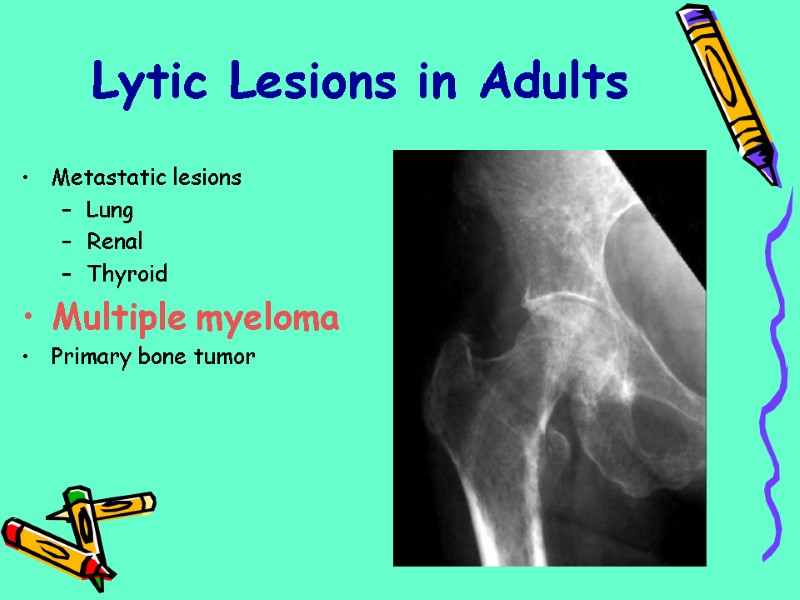
Metastatic lesions Lung Renal Thyroid Multiple myeloma Primary bone tumor Lytic Lesions in Adults
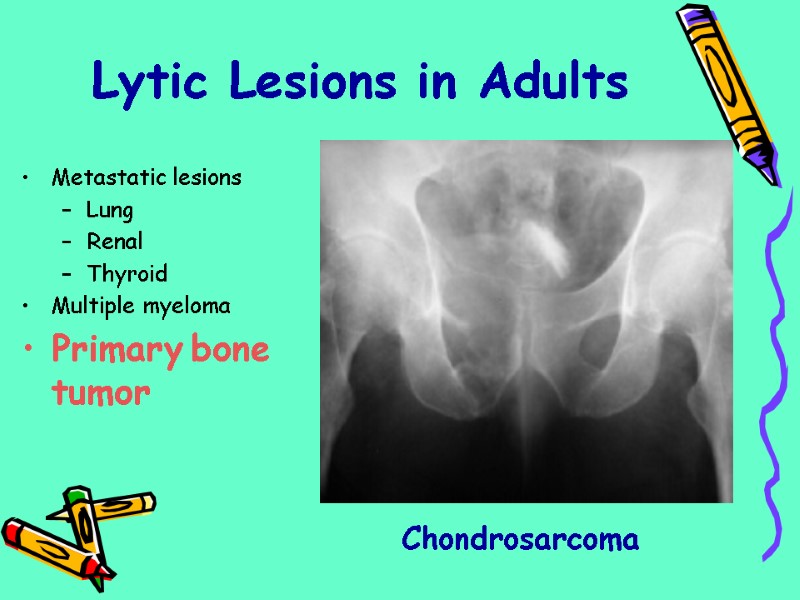
Metastatic lesions Lung Renal Thyroid Multiple myeloma Primary bone tumor Chondrosarcoma Lytic Lesions in Adults

Lymphoma Blastic Lesions in Children
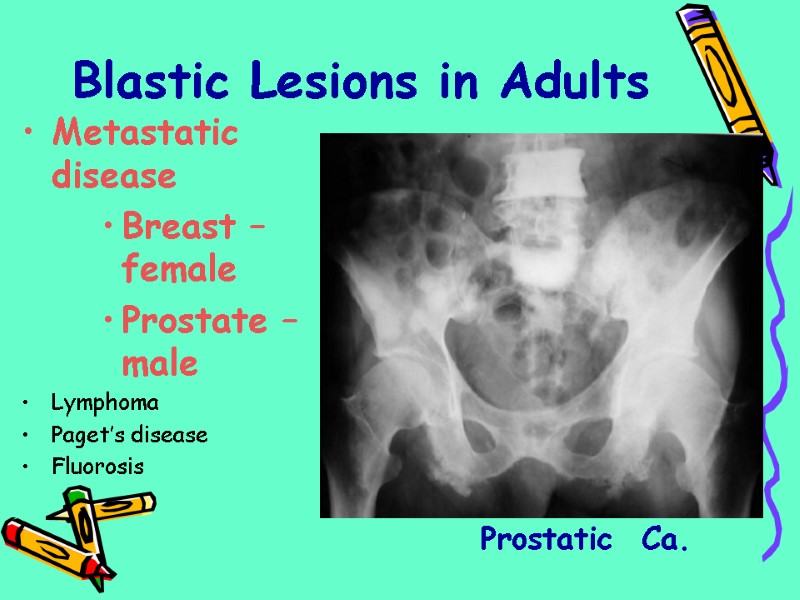
Metastatic disease Breast –female Prostate –male Lymphoma Paget’s disease Fluorosis Prostatic Ca. Blastic Lesions in Adults
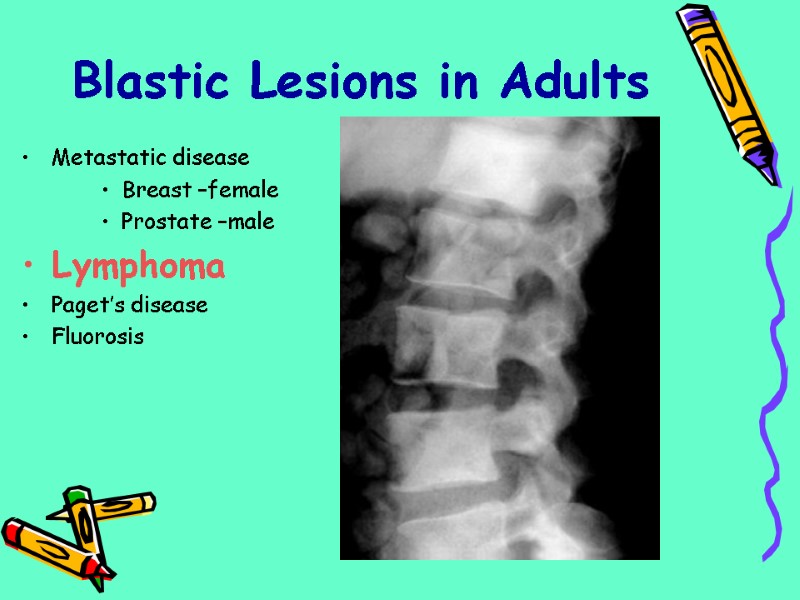
Metastatic disease Breast –female Prostate –male Lymphoma Paget’s disease Fluorosis Blastic Lesions in Adults
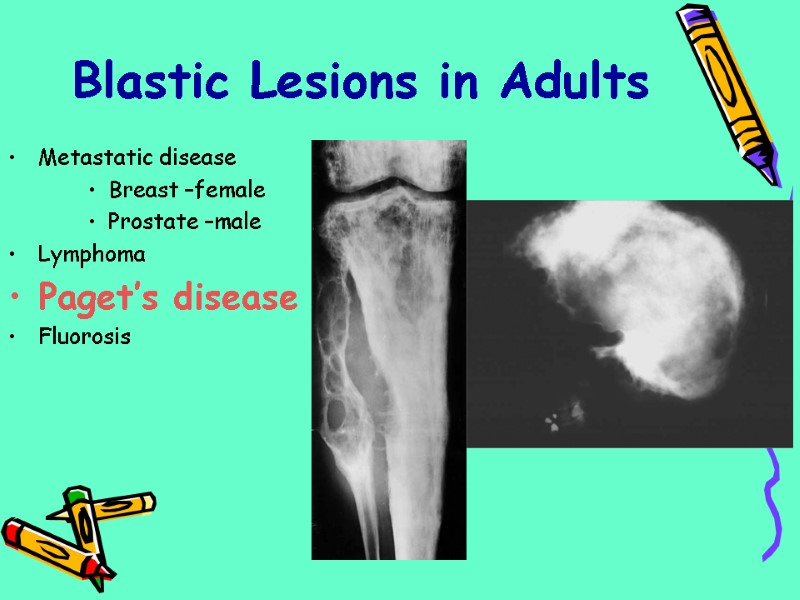
Metastatic disease Breast –female Prostate –male Lymphoma Paget’s disease Fluorosis Blastic Lesions in Adults
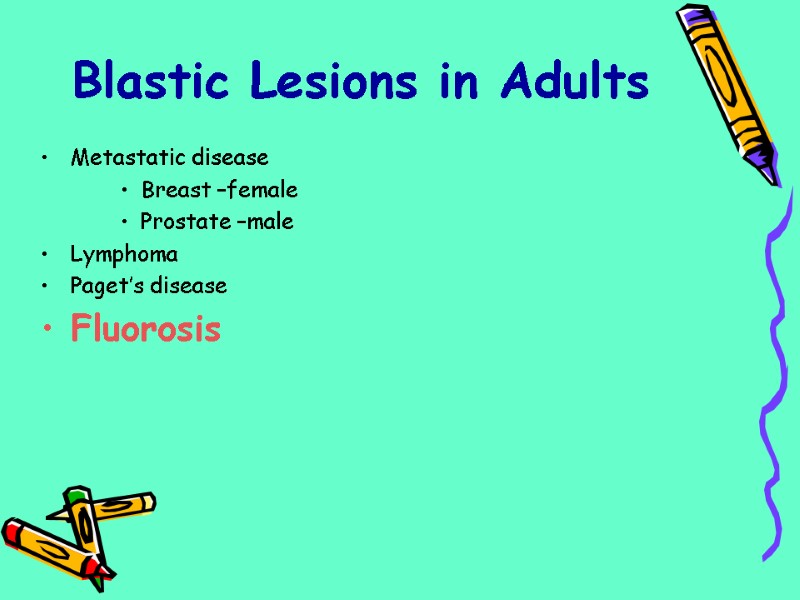
Metastatic disease Breast –female Prostate –male Lymphoma Paget’s disease Fluorosis Blastic Lesions in Adults
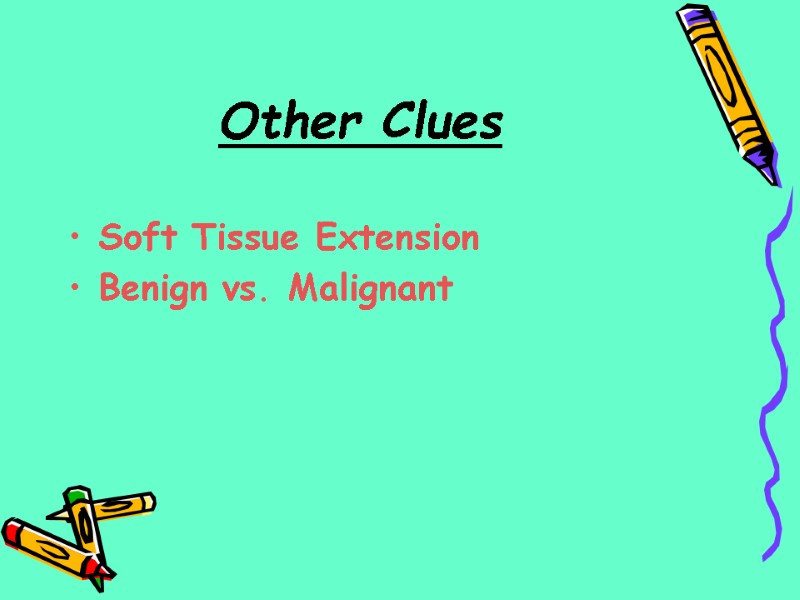
Other Clues Soft Tissue Extension Benign vs. Malignant
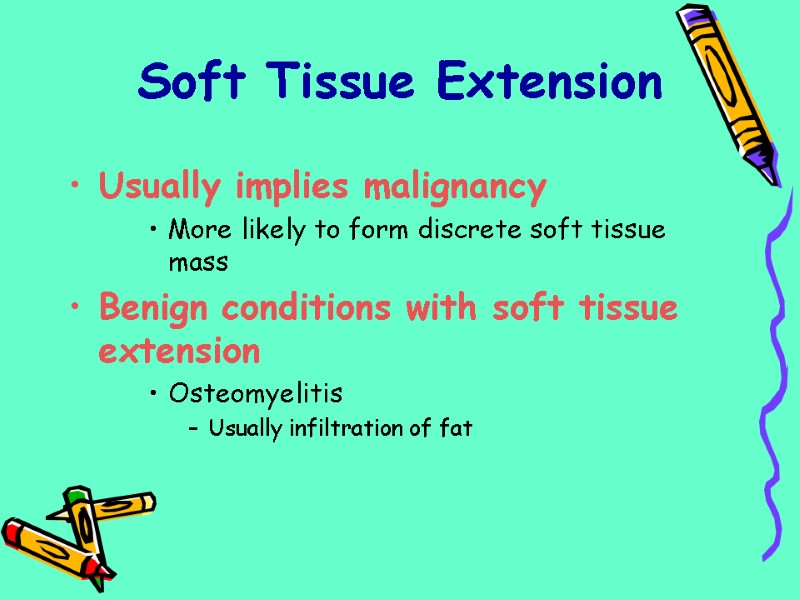
Soft Tissue Extension Usually implies malignancy More likely to form discrete soft tissue mass Benign conditions with soft tissue extension Osteomyelitis Usually infiltration of fat
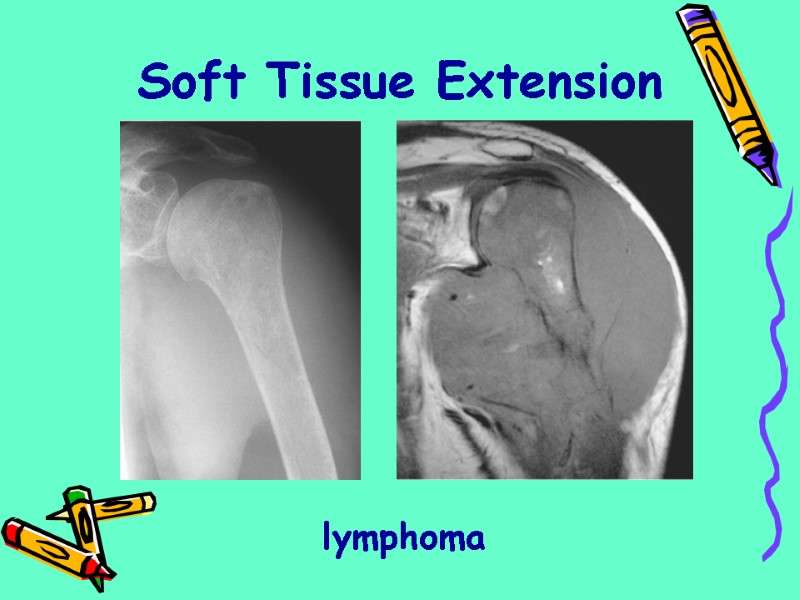
lymphoma Soft Tissue Extension
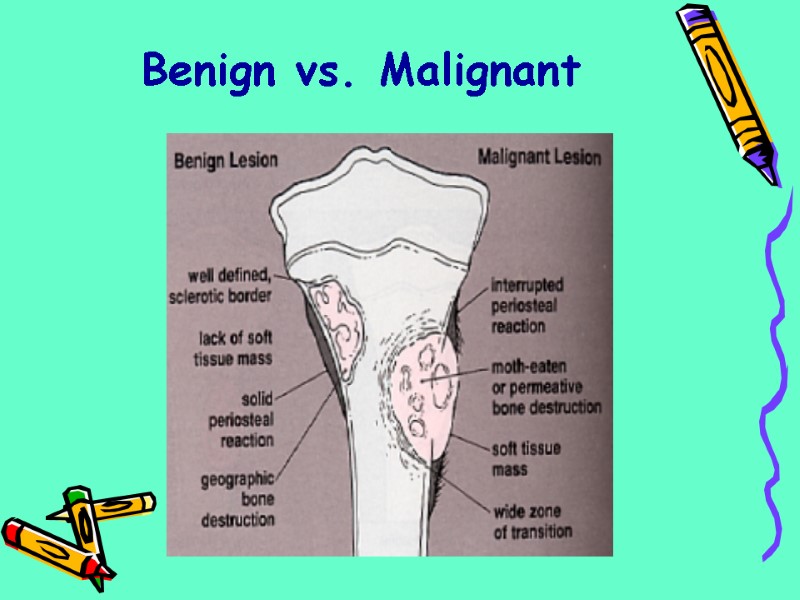
Benign vs. Malignant

Thank You
15470-bone-tumor.ppt
- Количество слайдов: 59

